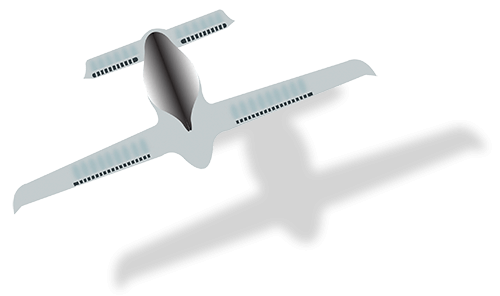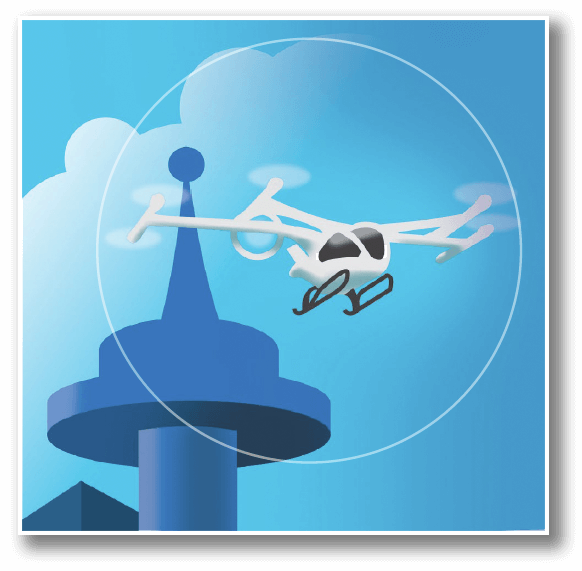Few other industries spur the kind of excitement about the latest and greatest advances just around the corner than aviation, so it’s understandable if some view the rosy predictions regarding electric aircraft, advanced air mobility (AAM) and other near-future technologies with some degree of skepticism.
That said, there’s a sense of momentum and purpose that differentiates today’s environment from that of 15-20 years ago, when some forecasters predicted that very light jets would darken the skies.
By one estimate, more than 400 companies are currently involved in some aspect of AAM, from developing electric vertical takeoff and landing (eVTOL) vehicles and the innovative propulsion systems that will power the next generation of aircraft, to laying the groundwork for the infrastructure necessary to support AAM operations. Government agencies, including the FAA and NASA, are working to safely integrate these new-generation aircraft into the national airspace system.
While some attrition will inevitably occur in the number of entities working on AAM, innovative concepts are driving progress toward making these dynamic concepts a reality.
“We’ve seen a tremendous amount of investment in these [advance air mobility] companies, and while that doesn’t mean all will be successful, it is a differentiator over the previous generation of advancements. ”
Parimal Kopardekar Director, NASA Aeronautics Research Institute
“In addition to significant forces like technological progress and the drive toward sustainability, there’s a non-technical ‘third dimension’ at work,” noted Parimal “PK” Kopardekar, director of NASA’s Aeronautics Research Institute (NARI). “We’ve seen a tremendous amount of investment in these companies, and while that doesn’t mean all will be successful, it is a differentiator over the previous generation of advancements that were largely driven by a small number of entrepreneurs, private equity firms or OEMs.”
“The last five years has been a really interesting period for the sector, and I think the next five years will be equally exciting,” agreed James McMicking, vice president of strategy for ZeroAvia. “We’ve seen electrification open up new ideas around how we can use the sky, and we’ve also seen escalation in the urgency to mitigate aviation’s climate impact. We must think creatively about how to do that, and it’s good to challenge the process a bit to see how we can do that quicker.”
 Matt Byrd, president and CEO of Hillwood, calls the current environment “an inflection point” for global aviation.
Matt Byrd, president and CEO of Hillwood, calls the current environment “an inflection point” for global aviation.
“The Wright Brothers changed our world with powered flight in 1903, and jet propulsion changed our world again in the 1950s,” explained Byrd. “And now, with electric, fly-by-wire flight control systems and advanced digital construction methods, we’re able to bring the air to the masses in an affordable rate that is highly innovative and that will help democratize air travel.”
While electric aircraft and AAM vehicles are not yet flying in commercial service, it may happen much sooner than some think.
“I wouldn’t be in my job if I thought we faced a 20-year lead time for this to take off,” said Taylor Alberstadt, global sales and marketing leader for unmanned aircraft systems (UAS) and unmanned air mobility (UAM) at Honeywell. “In five years, I believe there will be hundreds of vehicles operating in select cities globally, and I expect we’ll be able to take our first flights in AAM vehicles no later than 2027.”
Here’s a snapshot of just a small fraction of the development work being done today to make that happen.
Supporting the AAM Operating Environment
While eVTOL and AAM are relatively new concepts, NASA has worked extensively on the concept of aerial mobility and is applying lessons from current agency initiatives, including its Unmanned Aircraft System Traffic Management (UTM) project, to inform the process of integrating AAM into the national airspace system.
“You must look not just at the technology, but also readiness, acceptance by society, manufacturing and supply chain issues, and, of course, capital,” said Parimal “PK” Kopardekar, director of NASA’s Aeronautics Research Institute (NARI). Regulatory compliance, while outside NASA’s purview, will also influence how quickly AAM and electric aircraft gain a foothold in the industry.
“This is an entire ecosystem, with not only aircraft, but also infrastructure and community integration, that must all work together,” continued Kopardekar. “Enabling future air traffic management and airspace operations that harmoniously and peacefully coexist, without interfering with each other, requires a totally different, performance-based type of system.”
 Lessons learned as NASA has leveraged existing resources to improve distribution of needed supplies will also influence this work. One example is a 2020 intern-led NASA initiative that matched suppliers with volunteer pilot organizations using general aviation aircraft to deliver 200,000 meals and cases of bottled water for distribution to families in need across Eastern Arizona and New Mexico’s Zuni Pueblo.
Lessons learned as NASA has leveraged existing resources to improve distribution of needed supplies will also influence this work. One example is a 2020 intern-led NASA initiative that matched suppliers with volunteer pilot organizations using general aviation aircraft to deliver 200,000 meals and cases of bottled water for distribution to families in need across Eastern Arizona and New Mexico’s Zuni Pueblo.
“It was fascinating to see how advanced air mobility could make such a difference,” Kopardekar said. “We are now able to envision a new and different type of aviation, unlike anything seen before.”
Seeking AAM Propulsion Solutions
Among the more vexing technological dilemmas facing AAM and other future aircraft designs is the matter of propulsion. Many innovators are trying to meet this challenge, and Honeywell Aerospace believes it may have a possible answer with the company’s proposed hybrid-electric turbogenerator, which mates the company’s HGT1700 auxiliary power unit (APU) to a one-megawatt generator.
With the APU already flying in Airbus A350 airliners, Honeywell recently announced completion of Phase 1 testing of the 280-pound generator, during which it was operated continuously at 900 kW, displaying a power density of approximately 8 kW per kg at approximately 97% efficiency, according to the company.
Taylor Alberstadt, global sales and marketing leader for unmanned aircraft systems (UAS) and unmanned air mobility (UAM) at Honeywell, said the company is looking at AAM applications across this emerging segment.
“It’s fantastic to be able to say, ‘here’s a megawatt of electric power, what do you want to do with it?’” said Alberstadt. “Series hybrid? Drive a propulsor? Auxiliary power? Deicing? This solution opens possibilities not necessarily tied to any one system.’”
AAM remains a focus for the company. In December 2020, Honeywell announced a memorandum of understanding with British startup Faradair Aerospace to collaborate on using the turbogenerator unit to power its Bio Electric Hybrid Aircraft. “They were one of the first customers we engaged with for feedback from the market,” Alberstadt noted.
From just a handful of employees a few years ago, Honeywell now has more than 50 people working specifically on AAM and UAS across the engineering, program management, marketing and sales divisions of the company.
“We’re all-in on this technology,” Alberstadt said. “Our focus is on technologies contributing to a more sustainable future and helping customers who are helping the world at large.”

Demonstrating Capabilities and Developing Infrastructure
Backed by storied entrepreneur and aviator Ross Perot Jr., Hillwood is leveraging its 27,000-acre multi-modal “Mobility Innovation Zone” at Alliance Airport (FTW) in Fort Worth, TX, to help develop the infrastructure necessary to support AAM and other future aviation operations.
“Regional air mobility is where computing power meets avionics meets digital manufacturing,” said President and CEO Matt Byrd. “The technology is there, but we’ve got some work to do with [air traffic control], noise, community acceptance and infrastructure. But it’s hugely exciting and we’re [already] seeing it start to work.”
One example is Alphabet’s Wing program, in which UAS operated by the Google subsidiary deliver Walgreens pharmaceuticals to customers in the Dallas-Fort Worth metroplex. Hillwood is a supporting partner on that project, with UAS operating from its Frisco Station mixed-use development.
Byrd also points to Zipline, which is using UAS to deliver blood throughout Africa. “They’ve flown thousands of missions and haven’t crashed a single vehicle,” he noted, “and they’re saving lives in these remote areas where they don’t have the infrastructure. That helps with the acceptance.
“First, we do small cargo, then move into larger cargo vehicles,” he continued. “Then pilot passenger travel to existing airports and heliports, followed by investment in dedicated vertiports when the revenue stream makes sense.”
While cautious about expanding vertiports too quickly, “when customers realize how much they’ll love this service and are willing to pay for it, you will see vertiports spring up all around the world,” he predicted.
Bridging the Power Gap With Hydrogen Fuel Cells
Even as the aviation industry works toward full electrification, many early AAM vehicles and other sustainability-focused aircraft designs will rely on hybrid-electric propulsion systems that, at least in part, will continue to use petroleum-fueled powerplants. ZeroAvia is working on another option, by replacing conventional aircraft turbine engines with hydrogen-electric powertrains.
“If you want to pack a lot of energy, you need a very big battery, which means a lot of weight,” said James McMicking, the company’s vice president of strategy. “That makes it very difficult to design a viable aircraft with any meaningful payload and range. Fundamentally, you can move a very large amount of energy with hydrogen more easily than you can with the increasingly large batteries that would be needed for larger planes.”
ZeroAvia is currently working on a 19-passenger Dornier 228 twin-engine regional turboprop testbed with one ZA600 hydrogen-electric powertrain paired with one of the aircraft’s existing Honeywell TPE331 turboprop engines. McMicking anticipates first flight this summer, with subsequent follow-ons incorporating full hydrogen-electric propulsion on 40- and 72-seat turboprops, and eventually even larger aircraft.
 “The aim is to make a standard powerplant that can be fitted to a range of aircraft in the nine- to 19-seat category,” McMicking explained. The engine would be powered by gaseous hydrogen, with certification targeted in 2024. “We’re already laying many of the technology foundations for a two- to five-megawatt powerplant … to have ready for service in 2027.”
“The aim is to make a standard powerplant that can be fitted to a range of aircraft in the nine- to 19-seat category,” McMicking explained. The engine would be powered by gaseous hydrogen, with certification targeted in 2024. “We’re already laying many of the technology foundations for a two- to five-megawatt powerplant … to have ready for service in 2027.”
In addition to working through the technical challenges of on-aircraft hydrogen power, ZeroAvia is also exploring the infrastructure needed to distribute both gaseous and liquid hydrogen at airports on a large scale. The company has demonstrated a mobile hydrogen refueling truck concept, with additional work being done on airside and landside pipeline systems.
“We have a few partnerships in this area, combining both on- and off-site production,” McMicking noted. “That learning process will continue into the future as we begin to see larger-scale projects that provide larger quantities of hydrogen.
Review NBAA’s advanced air mobility resources at nbaa.org/aam.



 International Business Aviation Council Ltd.
International Business Aviation Council Ltd.